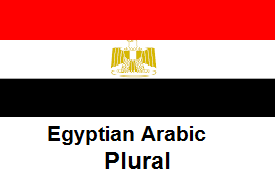Language/Egyptian-arabic/Grammar/Plural
Egyptian Arabic is a rich and complex language with many rules for forming plurals. In this lesson, we will cover the basic rules for forming plurals in Egyptian Arabic and provide examples to help you understand and apply these rules in practice.
Don't miss the chance to check out these pages as you wrap up this lesson: Egyptian-arabic Grammar, Adjectives, Command Form & Nouns.
Regular Plurals[edit | edit source]
The most common way to form plurals in Egyptian Arabic is by adding "oun" to the end of the singular noun. For example:
- "madrasa" (school) becomes "madaris" (schools)
- "kitab" (book) becomes "kutub" (books)
Irregular Plurals[edit | edit source]
Some singular nouns in Egyptian Arabic change their form entirely when forming plurals. For example:
- "bint" (girl) becomes "banat" (girls)
- "ra's" (head) becomes "ruus" (heads)
Feminine Plurals[edit | edit source]
Feminine singular nouns often take a different form when forming plurals, typically by adding "at" to the end of the word. For example:
- "sitt" (lady) becomes "sitat" (ladies)
- "fatma" (virgin) becomes "fatamat" (virgins)
Dual Plurals[edit | edit source]
In some cases, nouns in Egyptian Arabic can take dual forms when referring to two of something. This is formed by adding "ayn" to the end of the noun. For example:
- "yad" (hand) becomes "yadayn" (hands)
- "wijdan" (passion) becomes "wijdanyn" (passions)
Collective Plurals[edit | edit source]
Collective nouns in Egyptian Arabic refer to a group of things considered as a single entity. These nouns often take a different form when forming plurals, typically by adding "oun" to the end of the word. For example:
- "ahl" (people) becomes "ahluoun" (peoples)
- "jins" (gender) becomes "jinsoun" (genders)
In conclusion, forming plurals in Egyptian Arabic can be challenging, but with practice and exposure to the language, these rules will become second nature. By understanding and applying these rules, you will be able to communicate effectively and confidently in Egyptian Arabic.
Other Lessons[edit | edit source]
- Indefinite and definite articles
- Genitive Case
- How to Use Have
- Pronouns
- Nouns
- Plurals
- Possession
- Adjectives
- How to use the modal verb Must


